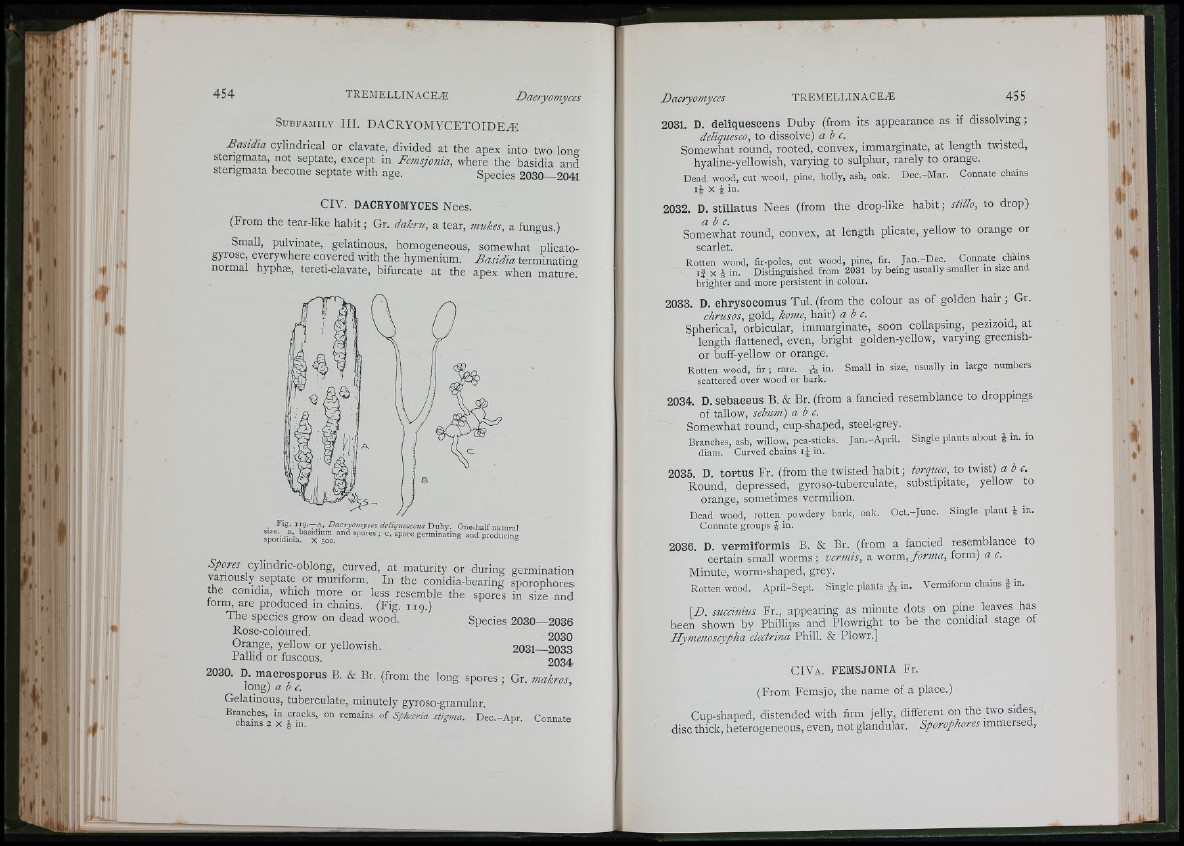
'M
•I
454 T R E M E L L IN A C EÆ Dacryomyces
S u b f a m i l y III. DACRYOMYCETOIDEÆ
Basidia cylindrical or clavate, divided at the apex into two long
sterigmata, not septate, except in Femsjonia, where the basidia and
sterigmata become septate with age. Species 2030—2041
CIV. DACRYOMYCES Nees.
(From the tear-like habit; Gr. dakru, a tear, mukes, a fungus.)
Small, pulvinate, gelatinous, homogeneous, somewhat plicato-
gyrose, everywhere covered with the hymenium. Basidia terminating
normal hyphæ, tereti-clavate, bifurcate at the apex when mature.
i r i - T d ’ Dacryomyces deliqueseens Duby. One-half natural
sporidiola X ™ “ ' ®’ “"d producing
Spores cylindric-oblong, curved, at maturity or during germination
variously septate or muriform. In the conidia-bearing sporophores
the conidia, which more or less resemble the spores in size and
iorm, are produced in chains. (Fig. 119.)
The species grow on dead wood. Species 2030—2036
Rose-coloured, 2030
Orange, yellow or yellowish. 2031__2033
Pallid or fuscous. 2034
2030. D. maerosporus B. & Br. (from the long spores; Gr. makros,
long) abc. ^ ,
Gelatinous, tuberculate, minutely gyroso-granular.
X ® T n Sphceria stigma. D e c .-A p r . Connate
TREMELLINACEÆ 455
2031. D. deliqueseens Duby (from its appearance as if dissolving;
deliquesco, to dissolve) abc. , ■ a
Somewhat round, rooted, convex, immarginate, at length twisted,
hyaline-yellowish, varying to sulphur, rarely to orange.
Dead wood, cut wood, pine, holly, ash, oak. Dec.-Mar. Connate chains
I® X J in.
2032. D. stillatus Nees (from the drop-like habit; stillo, to drop)
Somewhat round, convex, at length plicate, yellow to orange or
scarlet.
Rotten wood, fir-poles, cut wood, pine, fir. Jan.-Dee. Connie chains
i f X i in. Distinguished from 2031 by being usually smaller in size and
brighter and more persistent in colour.
2033. D. ehrysoeomus Tul. (from the colour as of golden hair ; Gr.
chrusos, gold, kome, hair) abc.
Spherical, orbicular, immarginate, soon collapsing, pezizoid, at
length flattened, even, bright golden-yellow, varying greemsh-
or buff-yellow or orange.
Rotten wood, fir ; rare. A “ ■ Small in size, usually in large numbers
scattered over wood or bark.
2034. D. sehaeeus B. & Br. (from a fancied resemblance to droppings
of tallow, sebum) abc.
Somewhat round, cup-shaped, steel-grey.
Branches, ash, willow, pea-sticks. Jan.-April. Single plants about ® in. m
diam. Curved chains i | in.
2035. D. tortus Fr. (from the twisted habit; torqueo, to twist) abc.
Round, depressed, gyroso-tuberculate, substipitate, yellow to
orange, sometimes vermilion.
Dead wood, rotten powdery bark, oak. Oct.-June. Single plant ® m.
Connate groups ® in.
2036. D. vermiformis B. & Br. (from a fancied resemblance to
certain small worms; vermis, a suorm, forma, form) a c.
Minute, worm-shaped, grey.
Rotten wood. April-Sept. Single plants in. Vermiform chains f in.
\D. succinius Fr., appearing as minute dots on pine leaves has
been shown by Phillips and Plowright to be the conidial stage ot
Hymenoscypha electrina Phill. & Plowr.]
C I V a . femsjonia Fr.
(From Femsjo, the name of a place.)
Cup-shaped, distended with firm jelly, different on the two sides,
disc thick, heterogeneous, even, not glandular. Sporophores immersed,
Tjc-
!'! t
'41 «
'ii*
1 !' ' '
i
i;